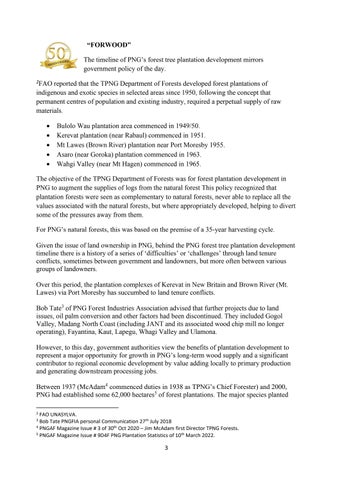“FORWOOD” The timeline of PNG’s forest tree plantation development mirrors government policy of the day. 2FAO
reported that the TPNG Department of Forests developed forest plantations of indigenous and exotic species in selected areas since 1950, following the concept that permanent centres of population and existing industry, required a perpetual supply of raw materials. • • • • •
Bulolo Wau plantation area commenced in 1949/50. Kerevat plantation (near Rabaul) commenced in 1951. Mt Lawes (Brown River) plantation near Port Moresby 1955. Asaro (near Goroka) plantation commenced in 1963. Wahgi Valley (near Mt Hagen) commenced in 1965.
The objective of the TPNG Department of Forests was for forest plantation development in PNG to augment the supplies of logs from the natural forest This policy recognized that plantation forests were seen as complementary to natural forests, never able to replace all the values associated with the natural forests, but where appropriately developed, helping to divert some of the pressures away from them. For PNG’s natural forests, this was based on the premise of a 35-year harvesting cycle. Given the issue of land ownership in PNG, behind the PNG forest tree plantation development timeline there is a history of a series of ‘difficulties’ or ‘challenges’ through land tenure conflicts, sometimes between government and landowners, but more often between various groups of landowners. Over this period, the plantation complexes of Kerevat in New Britain and Brown River (Mt. Lawes) via Port Moresby has succumbed to land tenure conflicts. Bob Tate3 of PNG Forest Industries Association advised that further projects due to land issues, oil palm conversion and other factors had been discontinued. They included Gogol Valley, Madang North Coast (including JANT and its associated wood chip mill no longer operating), Fayantina, Kaut, Lapegu, Whagi Valley and Ulamona. However, to this day, government authorities view the benefits of plantation development to represent a major opportunity for growth in PNG’s long-term wood supply and a significant contributor to regional economic development by value adding locally to primary production and generating downstream processing jobs. Between 1937 (McAdam4 commenced duties in 1938 as TPNG’s Chief Forester) and 2000, PNG had established some 62,000 hectares5 of forest plantations. The major species planted 2
FAO UNASYLVA. Bob Tate PNGFIA personal Communication 27th July 2018 4 PNGAF Magazine Issue # 3 of 30th Oct 2020 – Jim McAdam first Director TPNG Forests. 5 PNGAF Magazine Issue # 9D4F PNG Plantation Statistics of 10th March 2022. 3
3




